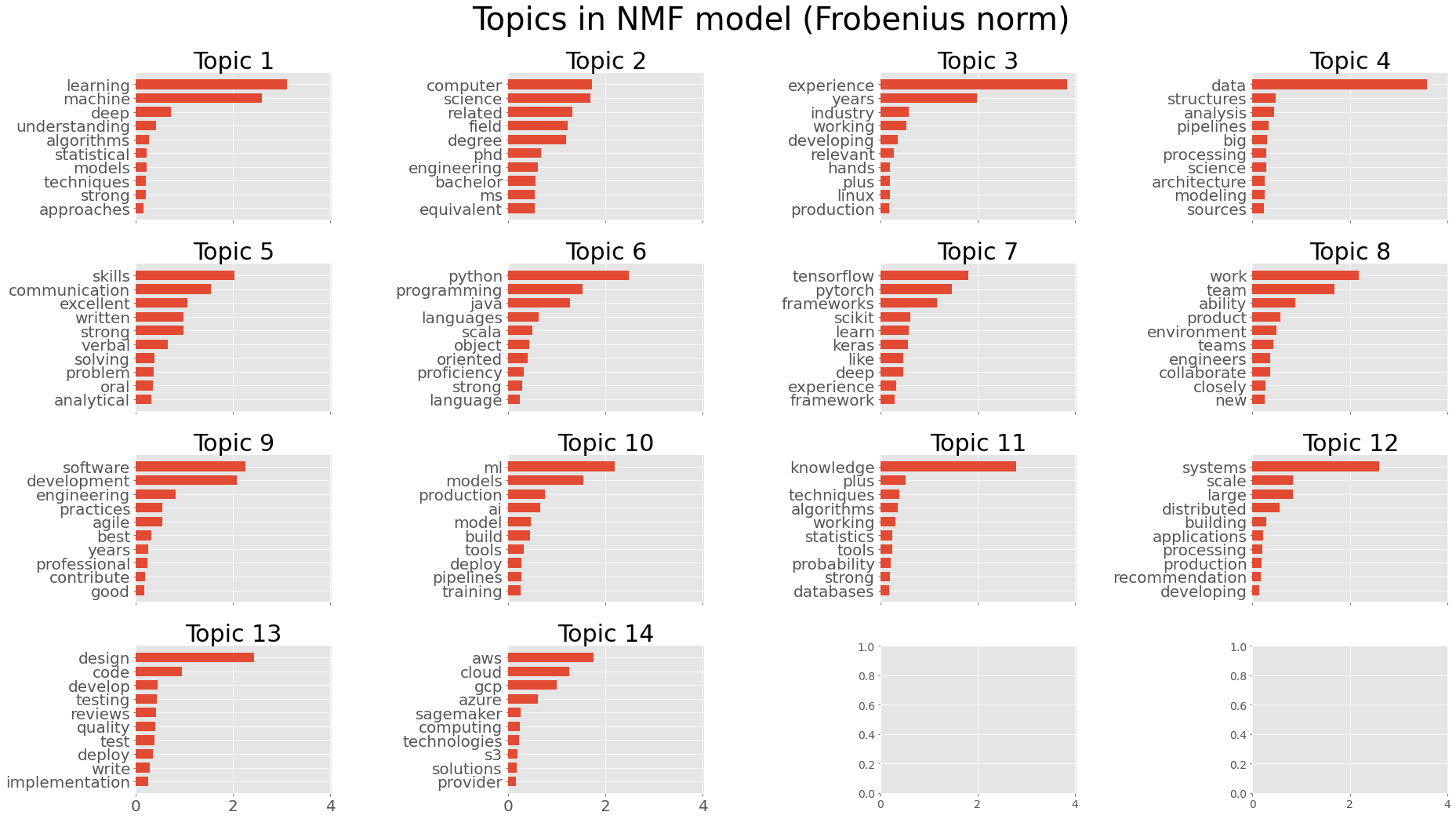We provide a machine learning tool that helps job seekers and professionals identify the most important skills and phrases for a specific position title. By scraping job descriptions from popular job boards and applying natural language processing techniques, SkillSurf produces a list of key topics and skills that are most commonly associated with a given job title. These topics and skills can be used to guide career development, inform job searches, and identify areas for improvement.
- Compile the skills text into a corpus after scraping indeed for job title
- Text vectorization into numerical feature vectors using term frequency inverse document frequency
- term frequency * inverse document frequency
- Words very frequently occurring in the corpus approach 0, infrequent words approach 1
- UNORDERED vector (e.g., dog has bone == bone dog has)
- Non-negative matrix factorization which produces
kcomponents withWweights, the factorization of the input dataN x M, e.g.,N x M -> W x k * k x N - Train a w2v model using the corpus for benchmarking
- Within each NMF cluster (e.g., each topic) average the w2v similarity ranking between each combination of words to calculate a ‘topic coherence’
- mean topic coherence within each topic, and compute a mean coherence for the model across all topics
The webscraper uses BeautifulSoup to parse content from the online job board Indeed. Indeed.com allows for a number of search filters, but for this example only 3 are used. A search string (Machine Learning Engineer), a location (United States), and the number of jobs returned per page (50).
from webscraper import Dataset
# Compile a list of URLs for N job postings
N=500
urls = []
title = 'Machine+Learning+Engineer'
for start in range(0, N, 50):
urls.append("https://www.indeed.com/jobs?q="+title+"&l=United+States&limit=50&start=" + str(start))
# parsing the html and store skills in csv
data = Dataset(URLS=urls)
data.populate_skills_dict()
data.preprocess_skills_dict()
data.save_csv("skills_dictionary_ML.csv")Compute term frequency-inverse document frequency for the entire corpus
from sklearn.feature_extraction.text import TfidfVectorizer
n_samples = 3000
n_features = 1500
n_components = 10
n_top_words = 10
data_samples = data._skills[:n_samples]
# term frequency–inverse document frequency
tfidf_vectorizer = TfidfVectorizer(max_df=0.95, min_df=2,
max_features=n_features,
stop_words='english')
tfidf = tfidf_vectorizer.fit_transform(data_samples)
tfidf_feature_names = tfidf_vectorizer.get_feature_names()Compute the non-negative matrix factorization
from sklearn.decomposition import NMF
topic_models = []
kmin = 4
kmax = 20
# assess model accuracy using 4-20 topic clusters
for k in range(kmin, kmax+1):
print("Applying NMF for k=%d ..." % k )
# Non-Negative Matrix Factorization
# https://scikit-learn.org/stable/modules/decomposition.html#nmf
model = NMF(n_components=k, random_state=1, alpha=.1, l1_ratio=.5, init="nndsvd")
W = model.fit(tfidf)
H = model.components_
#
topic_models.append( (k,W,H) )Train word2vec model on corpus
from sklearn.feature_extraction import text
import gensim
#tokens from skill text
docgen = TokenGenerator( data._skills, text.ENGLISH_STOP_WORDS )
#w2v model
model = gensim.models.Word2Vec(sentences=docgen, # Iterable for the tokenized text data
vector_size=200, # Dimensionality of the word vectors
min_count=2, # Ignores all words with total frequency lower than this
# (small dataset, so use 0)
sg=1) # Training algorithm: 1 for skip-gram; otherwise CBOWCalculate topic coherence
k_values = []
coherences = []
for (k,W,H) in topic_models:
term_rankings = []
for topic_index in range(k):
term_rankings.append( get_descriptor( tfidf_feature_names, H, topic_index, n_top_words ) )
# Now calculate the coherence based on w2v model
k_values.append( k )
coherences.append( calculate_coherence( model, term_rankings ) )
print("K=%02d: Coherence=%.4f" % ( k, coherences[-1] ) )We can visually see that using 14 topics produces the highest topic coherence for this job title.

